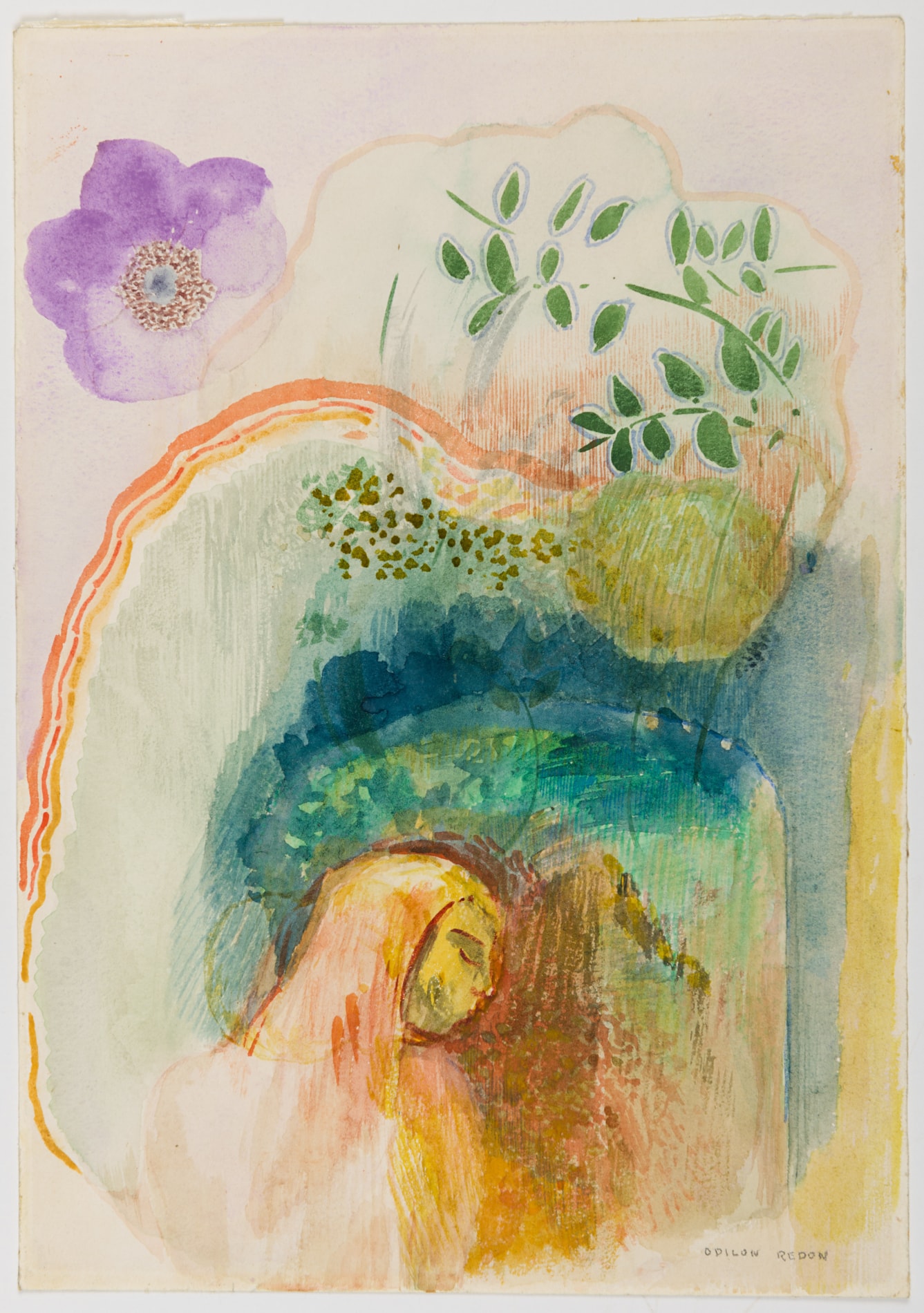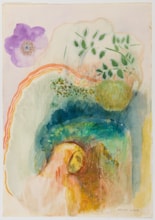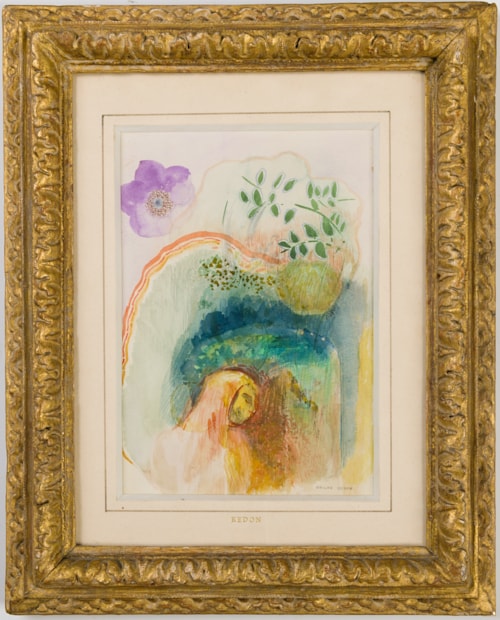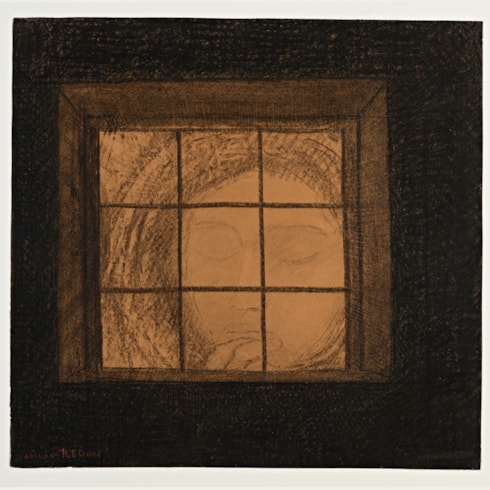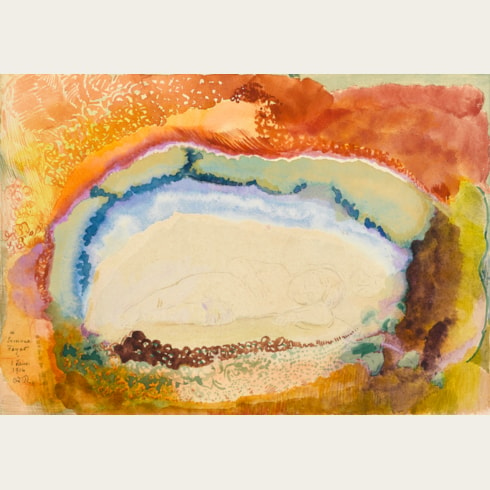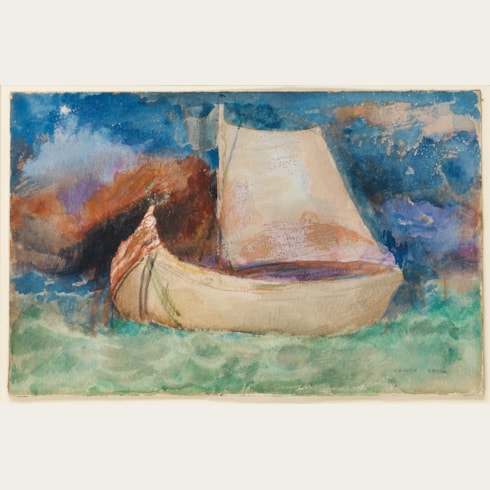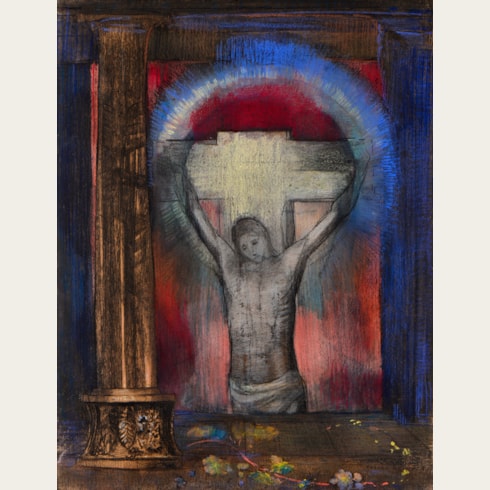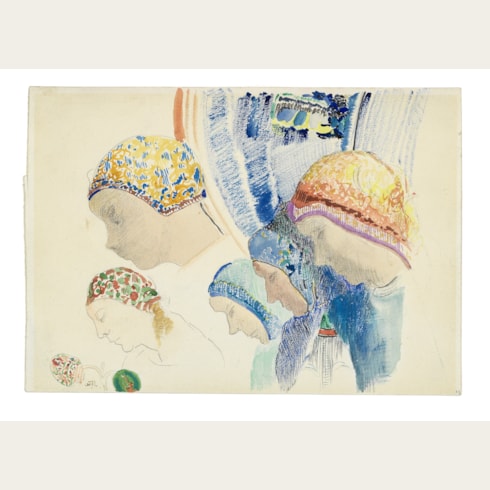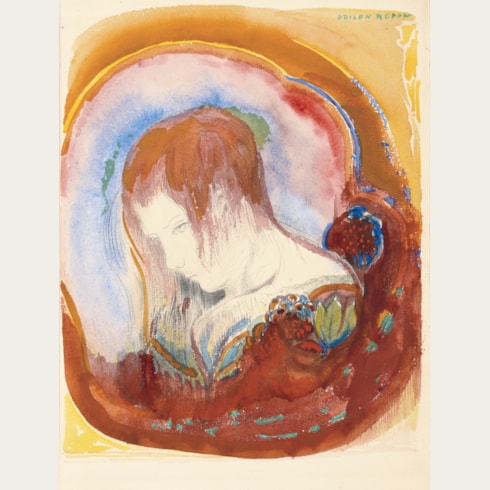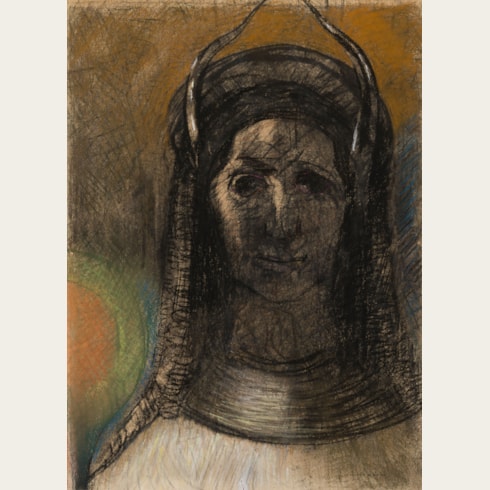Odilon REDON
(Bordeaux 1840 - Paris 1916)
La cape rose
Sold
Watercolour.
Signed ODILON REDON at the lower right. Inscribed Odilon Redon / “La cape rose” and numbered 20753 on the verso.
Inscribed Odile Redon / la cape rose on a label pasted onto the backing board.
Stamped P on the old backing board.
247 x 173 mm. (9 3/4 x 6 3/4 in.)
Signed ODILON REDON at the lower right. Inscribed Odilon Redon / “La cape rose” and numbered 20753 on the verso.
Inscribed Odile Redon / la cape rose on a label pasted onto the backing board.
Stamped P on the old backing board.
247 x 173 mm. (9 3/4 x 6 3/4 in.)
Odilon Redon’s use of watercolour is largely confined to the later years of his career, and reflects a more reserved side of his experiments with colour. Hiis work in this fluid medium seems to have been done largely for his own pleasure. His late watercolours were never exhibited in his lifetime, and seem to have been retained by the artist until his death, after which a number of examples were sold by his widow to such private collectors as Jacques Zoubaloff. Redon’s work as a watercolourist was first seen by the public only in posthumous exhibitions of his work, such as that held at the Galerie Bernheim-Jeune in 1917, in which the present sheet was included, or at the Galérie Barbazanges in 1920.
Datable to the early years of the 20th century, this watercolour - which was last exhibited in 1961 - depicts a figure enclosed by a sort of colourful aura or nimbus; a motif found in several of Redon’s compositions of the first and second decades of the 20th century. Like many of the artist’s works, the subject of the present sheet remains enigmatic, though it may be loosely grouped with around fifty paintings, pastels and drawings which are dominated by the theme of figures with their eyes closed.
Throughout his career Redon produced paintings, pastels and drawings of heads in profile; often idealized, sometimes grotesque, and always somewhat mysterious.
Datable to the early years of the 20th century, this watercolour - which was last exhibited in 1961 - depicts a figure enclosed by a sort of colourful aura or nimbus; a motif found in several of Redon’s compositions of the first and second decades of the 20th century. Like many of the artist’s works, the subject of the present sheet remains enigmatic, though it may be loosely grouped with around fifty paintings, pastels and drawings which are dominated by the theme of figures with their eyes closed.
Throughout his career Redon produced paintings, pastels and drawings of heads in profile; often idealized, sometimes grotesque, and always somewhat mysterious.
At a very young age, Odilon Redon was sent to live with an old uncle at Peyrelebade, a vineyard and estate surrounded by an abandoned park in a barren area of the Médoc region, northwest of Bordeaux. Here the young boy, who suffered from frail health and epilepsy, was to spend much of his childhood in relative solitude. Indeed, it was not until he was eleven that he was sent to school in Bordeaux, where at fifteen he began to take drawing classes. The most important influence on the young artist was Rodolphe Bresdin, whose studio in Bordeaux he frequented, and who was to prove decisive on his artistic development. It was from Bresdin, for example, that Redon learned the techniques of etching and lithography. Nevertheless, for most of his career Redon worked in something of an artistic vacuum, aware of the work of his contemporaries but generally preferring to follow his own path. His drawings and prints allowed him to express his lifelong penchant for imaginary subject matter, and were dominated by strange and unsettling images of fantastic creatures, disembodied heads and masks, solitary eyes, menacing spiders and other dreamlike forms. For much of the first thirty years of his career Redon worked almost exclusively in black, producing his ‘noirs’ in charcoal and chalk; the drawings he described as ‘mes ombres’, or ‘my shadows’.
It was not until 1881, when he was more than forty years old, that Redon first mounted a small exhibition of his work, to almost complete indifference on the part of critics or the public. The following year, however, a second exhibition of drawings and lithographs brought him to the attention of a number of critics. Redon’s reputation began to grow, and in 1884 he exhibited at the first Salon des Indépendants, which he had helped to organize. Two years later he was invited to show at the eighth and final Impressionist exhibition, and in the same year exhibited with Les XX, a group of avant-garde artists, writers and musicians in Brussels.
Towards the end of the 19th century Redon began to move away from working mainly in charcoal and black chalk in favour of a new emphasis on colour, chiefly using the medium of pastel but also watercolour, oil paint and distemper. Indeed, after about 1900 he seems to have almost completely abandoned working in black and white. Like his noirs, his pastels of floral still lives and portraits were popular with a few collectors, and several were included in exhibitions at Durand-Ruel in 1900, 1903 and 1906, and in subsequent exhibitions of his work in Paris and abroad. Despite this change in direction, however, Redon’s work remained unpopular with the public at large, and it was left to a few enlightened collectors to support the artist in his later years. Nevertheless, an entire room was devoted to Redon at the seminal Armory Show held in New York in 1913, an honour shared by Cezanne, Gauguin, Matisse and Van Gogh.
Provenance
The studio of the artist, and by descent to his widow, Camille
Acquired from her in 1916 by Galerie Bernheim-Jeune, Paris
Acquired from them in December 1917 by J. Laroche, Paris
Sam Salz, New York
By inheritance to his wife, Marina Salz, New York
Private collection
Sale, New York, Christie’s, 9 May 2000, lot 312
Private collection, California.
Acquired from her in 1916 by Galerie Bernheim-Jeune, Paris
Acquired from them in December 1917 by J. Laroche, Paris
Sam Salz, New York
By inheritance to his wife, Marina Salz, New York
Private collection
Sale, New York, Christie’s, 9 May 2000, lot 312
Private collection, California.
Literature
Alec Wildenstein, Odilon Redon: Catalogue raisonné de l’oeuvre peint et dessiné. Vol.I: Portraits et figures, Paris, 1992, p.181, no.456.
Exhibition
Paris, Bernheim-Jeune & Cie., Paysages d’après nature (peinture à l’huile), aquarelles et dessins par Odilon Redon (1840-1916), 1917, no.55 ter (as ‘Figure nue, palmes, roue’)
New York, The Museum of Modern Art and Chicago, The Art Institute of Chicago, Odilon Redon, Gustave Moreau, Rodolphe Bresdin, 1961-1962, no.66.
New York, The Museum of Modern Art and Chicago, The Art Institute of Chicago, Odilon Redon, Gustave Moreau, Rodolphe Bresdin, 1961-1962, no.66.

